Introduction
The same? Not exactly.
They certainly behave in a similar way when they encounter tissue at the right velocities, but they aren't exactly the same.
Generally M193 yaws a bit quicker and fragments a bit more completely inside of 100 meters or so.
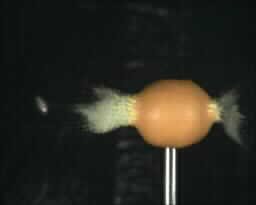
Here's an M193 FMJ round which has yawed 80 degrees after penetrating an orange (3.25 inches). (Note the nose is facing away from the camera).
Of course, M193 also has higher initial velocities generally as well as a smaller, weaker bullet so its fragmentation is often more dramatic than in M855 at close ranges. Still, both do a lot of tissue damage over 2700 fps.
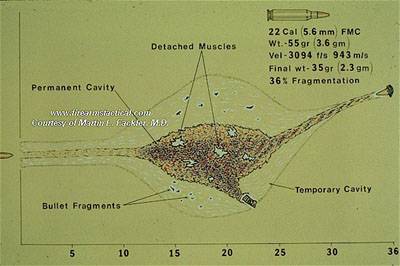
Wound profile of M193
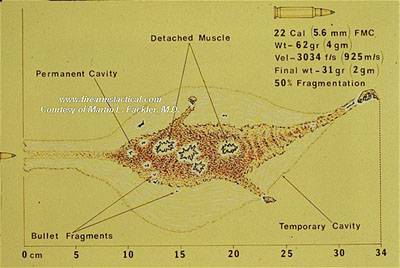
Wound profile of M855
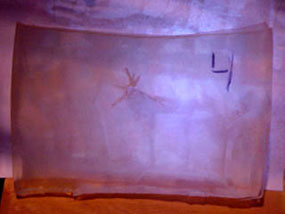
Cross-section of 1986 South African M193 wound profile from inch 3 to inch 4. Bullet has yawed and fragmentation has begun in earnest. (Source: Tatjana and Derek F.)
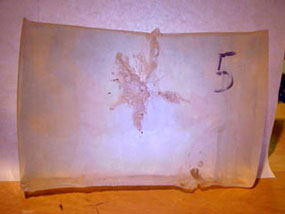
Cross-sections from inch 4 to inch 6. Notice the opening up of the wound profile, the significant deposit of fragments and substantial tissue damage
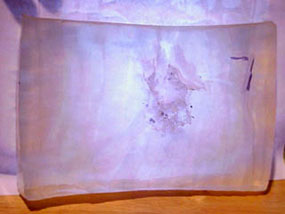
Cross-sections from inch 6 to inch 8. Note the closing of the wound profile and the larger size of fragments
As you can see, the wound cavity left by M193 is impressive. The wound profile starts opening up somewhere inside of 3". It is full blown fragmentation between 4" and 7". A torso shot has a very high probability of doing very serious damage to organs, certainly punching a large hole in lungs and/or heart tissue. M193 does seem to have a bit better penetration than M855 as well. Typically the nose of the bullet ends up penetrating to 13-14.5", traveling backwards through tissue.
Superimposing the 5"-6" depth wound cross-section on the human torso, adjusting for size, reveals the probable effectiveness of the round.

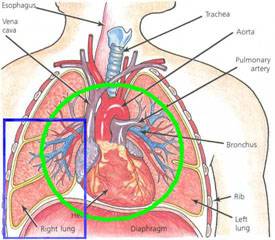
Representation of a M193 3100 fps torso strike 2.5" right of center mass (left). Representation of a 3100 fps M193 torso strike 3.5" left and 2" below center mass (right) Size adjusted to scale. Critical areas (in green) and area of maximum fragmentation and tissue disruption (in blue)
Clearly both strikes would result in serious damage to heart/lung tissue. The margin of error given by the large width and height of the M193 wound cavity is significant and may turn 2-3 MOA strikes which would be "near misses" in non-fragmenting or smaller wound cavity rounds into "hits." It's this massive cavity that makes many of us think fragmentation is the best wounding mechanism to try and take advantage of.
Remember that the only thing that will cause "instant" incapacitation is damage to the central nervous system. If you miss the CNS, you have to cause enough blood loss to debilitate the threat. That makes the goal to do as much vascular damage as possible.
Both M855 and M193 clearly meet FBI standards for penetration both in clothed and non-clothed strikes.
Despite this, there is growing concern over M855's performance based on recent field experience and testing. Partially because of the complex construction of M855/SS109 rounds their terminal performance often varies from lot to lot. As much as 6 and 7" of penetration have been observed before bullet yaw with some M855. While FBI standards do not specify fragmentation or yaw distance when evaluating rounds, given the importance of fragmentation in 5.56 bullets we are inclined to discourage use of M855 as a defensive round in light of the terminal performance and yaw consistency problems it continues to demonstrate.
FACTS:
The details of the FBI test protocol:
-
Test Event 1: Bare Gelatin
The gelatin block is bare and shot at a range of ten feet measured from the muzzle to the front of the block. This test event correlates FBI results with those being obtained by other researchers, few of whom shoot into anything other than bare gelatin. It is common to obtain the greatest bullet expansion in this test. Rounds which do not meet the standards against bare gelatin tend to be unreliable in the more practical test events that follow.
-
Test Event 2: Heavy Clothing
The gelatin block is covered with four layers of clothing: One layer of cotton T-Shirt material (48 threads per inch); one layer of cotton shirt material (80 threads per inch); a 10 ounce down comforter in cambric shell cover (232 threads per inch); and one layer of 13 ounce cotton denim (50 threads per inch). This simulates typical cold weather wear. The block is shot at ten feet, measured from the muzzle to the front of the block.
-
Test Event 3: Steel
Two pieces of 20 gauge, hot rolled steel with a galvanized finish are set three inches apart. The steel is in six-inch squares. The gelatin block is covered with light clothing and placed 18 inches behind the rear most piece of steel. The shot is made at a distance of I0 feet measured from the muzzle to the front of the first piece of steel. Light clothing is one layer of cotton T-shirt material and one layer of cotton shirt material and is used in all subsequent test events. The steel is the heaviest gauge steel commonly found in automobile doors. This test simulates the weakest part of a car door. In all car doors, there is an area, or areas, where the heaviest obstacle is nothing more than two pieces of 20 gauge steel.
-
Test Event 4: Wallboard
Two pieces of half-inch standard gypsum board are set 3.5 inches apart. The pieces are six inches square. The gelatin block is covered with light clothing and set 18 inches behind the rear most piece of gypsum. The shot is made ten feet, measured from the muzzle to the front surface of the first piece of gypsum. This test event simulates a typical interior building wall.
-
Test Event 5: Plywood
One piece of three-quarter inch AA fir plywood is used. The piece is six inches square. The gelatin block is covered with light clothing and set 18 inches behind the rear surface of the plywood. The shot is made at ten feet, measured from the muzzle to the front surface of the plywood. This test event simulates the resistance of typical wooden doors or construction timbers.
-
Test Event 6: Automobile Glass
One piece of A.S.I. one-quarter inch laminated automobile safety glass measuring 15 x 18 inches is set at an angle of 45 degrees to the horizontal. The line of bore of the weapon is offset 15 degrees to the side, resulting in a compound angle of impact for the bullet upon the glass. The gelatin block is covered with light clothing and set 18 inches behind the glass. The shot is made at ten feet, measured from the muzzle to the center of the glass pane. This test event with its two angles simulates a shot taken at the driver of a car from the left front quarter of the vehicle and not directly in front of it.
-
Test Event 7: Heavy Clothing at 20 yards
This event repeats test event 2 but at the range of 20 yards, measured from the muzzle to the front of the gelatin. This test event assesses the effects of increased range and consequently decreased velocity.
-
Test Event 8: Automobile Glass at 20 yards
This event repeats test event 6 but at a range of 20 yards, measured from the muzzle to the front of the glass and without the 15 degree offset. This shot is made from straight in front of the glass, simulating a shot at the driver of a car bearing down on the shooter.
In addition to the above described series of test events, each cartridge is tested for velocity and accuracy. Twenty rounds are fired through a test barrel and twenty rounds are fired through the service weapon used in the penetration tests.
Two ten-shot groups are fired from the test barrel and two ten-shot groups from the service weapon used, at 25 yards. They are measured from center to center of the two most widely spaced holes, averaged and reported.
MORE:

The central and peripheral nervous systems
- The average human only needs to lose about 20% of blood volume (only 1 liter) to induce shock and lose consciousness. 50% (2.5 liters) almost always causes death. Severe damage to a major vessel can cause as much as 1.5 liters a minute in hemorrhaging.
- The spinal cord is about the thickness of your pinky. It probably doesn't make a good primary target.
- According to the FBI the average human torso is 9 inches front to back.
Physiologically, a determined adversary can be stopped reliably and immediately only by a shot that disrupts the brain or upper spinal cord. Failing a hit to the central nervous system, massive bleeding from holes in the heart or major blood vessels of the torso causing circulatory collapse is the only other way to force incapacitation upon an adversary and this takes time. For example, there is sufficient oxygen within the brain to support full, voluntary action for 10-15 seconds after the heart has been destroyed. (Urey W. Patrick, FBI Firearms Training Institute).
 Win a FREE Membership!
Win a FREE Membership!